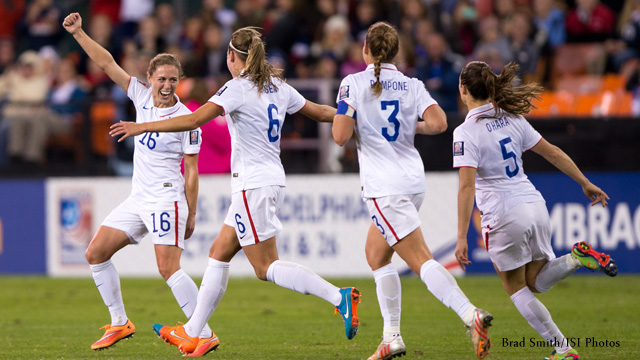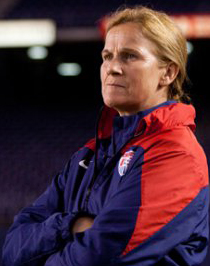USWNT’s course in this World Cup year? Steady as she goes

Let’s be honest, 2014 was not the smoothest year for the U.S. Women’s National Team.
Head coach Tom Sermanni was fired, seemingly out of the blue, in April. Sermanni’s replacement, Jill Ellis, was touted for her deep knowledge of the US WNT and rapport with the squad, yet under her leadership the team’s performances have been distinctly lackluster.
To be sure, the U.S. qualified for the World Cup—but it wasn’t pretty (especially against Trinidad & Tobago); and the 21 goals scored in qualifying were barely more than half as many as the 38 scored in qualifying for the 2012 Olympics, against many of the same teams. When the U.S. played a genuine rival in Brazil at the end of the year, they were ripped to shreds by Marta, then in the rematch resorted to defending deep in two banks of four for the first 70 minutes of the match.
+READ: USWNT embarrassed by Brazil as Jill Ellis’ decisions continue to puzzle
When Germany took over top spot in the FIFA World Rankings from the U.S. for the first time in seven years, it was hardly a surprise.
One might have said a possible avenue for improvement in this World Cup year would be to expand the player pool — to introduce competition for places in a squad that is, to put it bluntly, aging in place. (In the two recent matches against Brazil, for example, the average age of the two U.S. starting lineups was over 30.)
In particular, one might have thought it a good idea to to call in some of the defensive midfielders who have distinguished themselves in NWSL and college play, such as Becky Edwards, Jen Buczkowski, Keelin Winters, and Sarah Killion.
 To Jill Ellis? Not so much.
To Jill Ellis? Not so much.
The senior WNT is currently conducting a 29-player training camp. Twenty of those 29 were in the WNT’s February 2011 camp, in the runup to the last World Cup. Most of the rest are already deeply ensconced within the WNT setup — the closest to a fresh face is Allie Long. For that matter, the closest to a new defensive midfielder is Sam Mewis, who, given her playmaking and barnstorming runs from deep, may be more in the Yaya Toure mold than the pure shield for the back four that the U.S. lacks right now.
+READ: USWNT analysis: Will a real No. 6 please stand up?
In a way, Ellis’s refusal to countenance bringing in newcomers to the senior WNT is almost poetic. Left back has been a problem position for the U.S. since Lori Chalupny dropped out of the WNT picture due to concussions, to the point that Pia Sundhage and Tom Sermanni went to great lengths to convert Kelley O’Hara from a forward to a left back.
Ellis’s solution? Apparently, convince the federation to let her recall Chalupny. Similarly, the WNT has largely lacked a true specialist defensive midfielder since Shannon Boxx went down injured in the opening match of the 2012 Olympics. Does Ellis give a senior callup to someone like Edwards or Killion? No, she would rather bring in Boxx once again—never mind that Boxx, now 37, has only 7 appearances at club level since those same Olympics.
The most one can say for Ellis on this front is that she is looking at new players, via a “U-23” camp featuring successful collegians and 9 overage players. Of course, given the numbers, this latter camp seems intended to make up the numbers for the 35-player provisional roster, rather than provide a realistic opportunity to make the final 23. And even this justification does not explain why Ellis assigned certain players to the senior, rather than U-23 camp; nor why players like Edwards and Buczkowski — and, for that matter, Bianca Henninger, Kendall Fletcher, Leigh Ann Robinson, and Christine Nairn — are simply absent altogether.
+READ: Commentary: USWNT must drop Abby Wambach now, before it’s too late
None of this is new or a surprise, exactly. Ellis has worked with most of the players in the current senior WNT squad for years, after all. Indeed, Ellis was touted as someone who would be a good head coach precisely because she had such a long history and rapport with that set of players. It was Sermanni who was hired to preside over a generational transition — and look what happened to him. But in the context of the USWNT’s poor performances in 2014, the degree of continuity is still striking.
 Even the most cohesive club team must change personnel over time; the WNT appears determined to barely change at all.
Even the most cohesive club team must change personnel over time; the WNT appears determined to barely change at all.
Similarly, notwithstanding Ellis’s talk about moving to a fluid, open, attacking possession style, what we have seen on the field from the WNT, (and indeed the U-20s) since Ellis took over, though, is too often the same old story—a couple of passes followed by a punt or cross toward a big center forward, and a focus on set pieces.
The U.S. has plenty of players (including in the current senior team camp) who can possess the ball through the middle just fine; but that’s not how they are being directed to play. Apparently it is too much to ask that the WNT keep the ball on the deck and leave three-and-out to the NFL.
We are told that the competition is getting stiffer, that the rest of the world is catching up to the U.S. WNT. On this evidence, Ellis believes that the way to beat them is to stick with what’s worked for the U.S. so far. But, of course, the U.S. hasn’t won a World Cup in 15 years.











